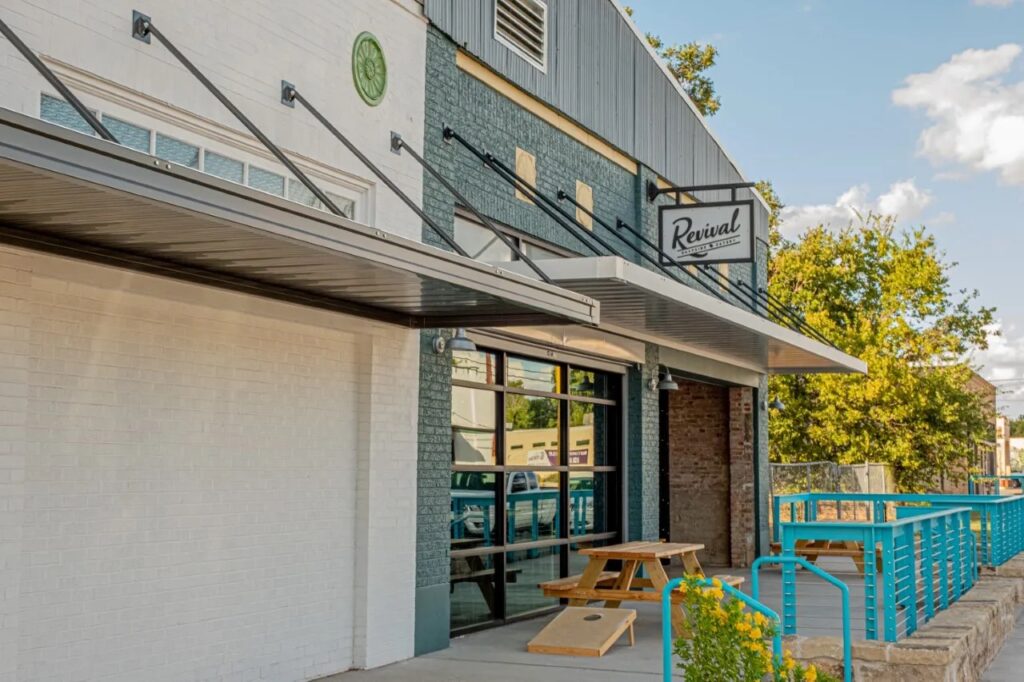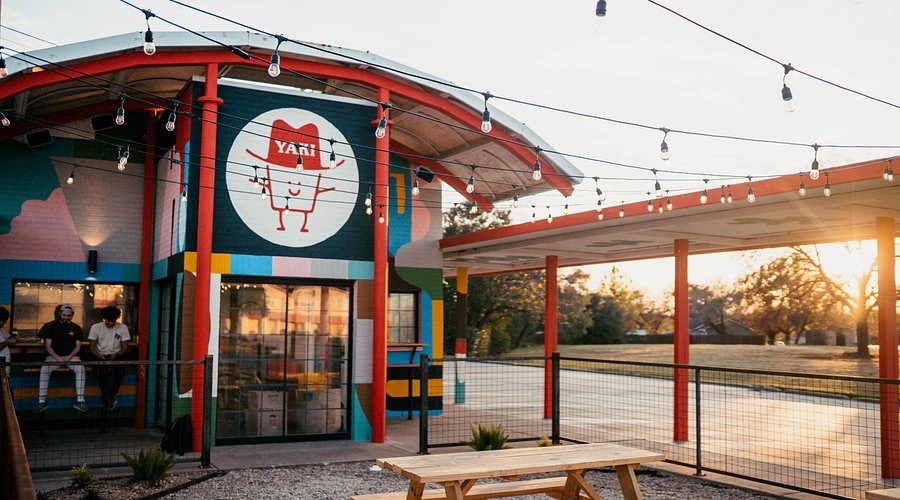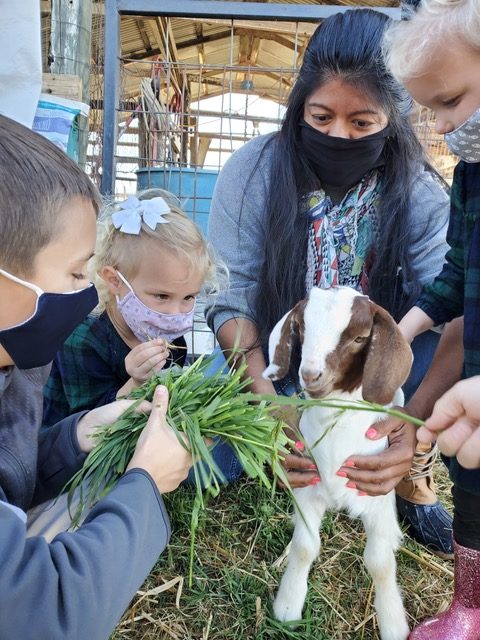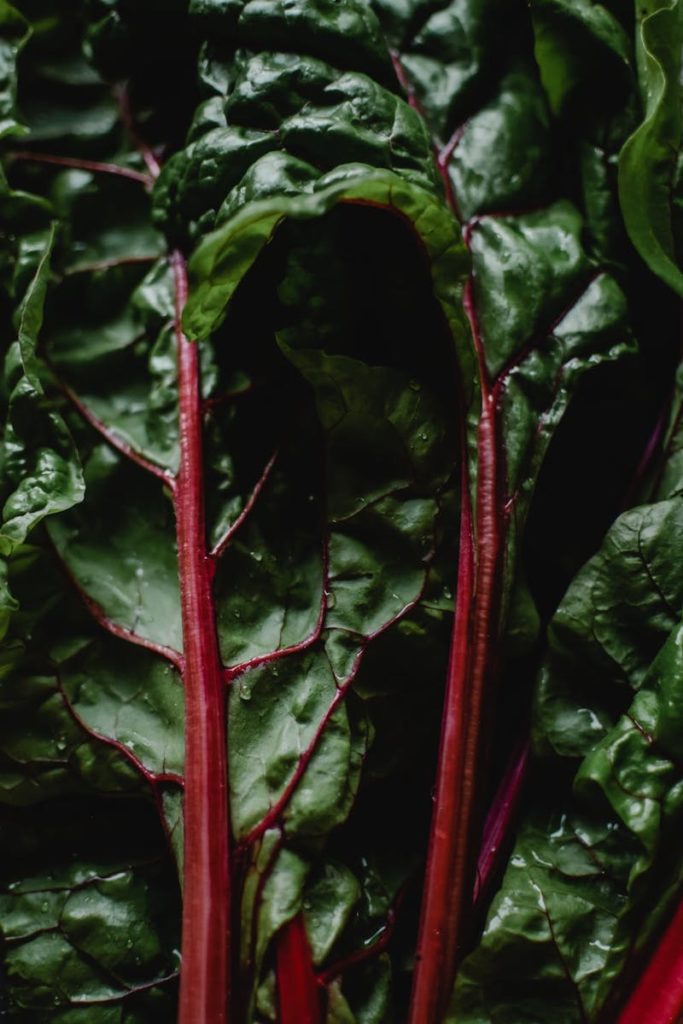Alpha Omega Grill & Bakery
929 Franklin Ave, Waco, TX 76701
Built out of an old transmission shop in historic downtown Waco, Alpha Omega Grill & Bakery is a fantastic Mediterranean joint serving gyro sandwiches, fresh pita, and mezze platters. There is much on this menu to obsess over, and a second location was opened in Hewitt for locals who couldn’t get enough. Alpha Omega offers gluten free, dairy free, and vegan options.

Around the World Bakery
119 N 12th St, Waco, TX 76701
This bakery and coffee shop is bringing internationally inspired desserts directly to downtown Waco. Owned by Hillsboro native, Adilene Camarena, this shop was inspired by the owner’s travels around the world and her own passions in culinary arts. With gluten free options, this bakery takes you around the world from your neighborhood.
Harvest on 25th
112 N 25th St, Waco, TX 76710
This locally owned farm to table restaurant in Waco serves breakfast and lunch everyday from 8 am to 3 pm. With vegan options, gluten free possibilities, and recipes that push the boundaries of standard food, Harvest has something to easily satisfy everyone. With picnic style tables, flowers at every turn, and laughter echoing through the space, Harvest is the place to be with some beautiful community.

Revival Eastside Eatery
704 Elm Ave, Waco, TX 76704
In the heart of historic East Waco, this female owned business serves up delicious salads, sandwiches, and burgers. With a list of craft beers and wine to sip on, Revival has everything you could possibly be craving! Try their iconic sweet potato fries or tomato soup, which are bursting with flavor in every bite.

YAKI Texas Teriyaki
1307 S Valley Mills Dr, Waco, TX 76711
Keeping it simple so that more can enjoy it, YAKI Texas Teriyaki is gluten, dairy, and nut free. This drive-in on Valley Mills serves BBQ rice boxes to-go. Spice up your favorite dish with specialty house sauces, also known as “soss.” Rice, protein, soss, and slaw–a complete meal in a box! Fun foods, crazy colors, and mindful meals makes YAKI one of the best.
While these facilities have gluten free options on the menu, it is important to consider cross contamination in all cases. Please double check with each eatery to confirm their gluten-free dedication. Some items from these places are not safe for those with celiac disease.

Elizabeth Riley hails from Tennessee and is a graduate of English Literature and Professional Writing & Rhetoric from Baylor University. With passions in archival preservation, communal connection, and women in sports, she writes because it matters, with hopes of bridging villages and fostering revelry amongst them.
WACO, Texas – The Greater Waco Sports Commission is looking for volunteers for two upcoming spring events: the Light Up the Dark 5K on April 12 and the 3V3 Basketball Tournament on April 25.

The Light Up the Dark 5K, presented by Chick-fil-A and hosted by Unbound Now, will take place at Cameron Park Zoo. This family-friendly race supports Unbound Now’s anti-human trafficking efforts. Multiple volunteer shifts are available, with some allowing participants to both volunteer and run in the 5K.
The 3V3 Basketball Tournament, hosted by Baylor University, will be held at Midway High School. Volunteers are needed to run the clock, update brackets and help keep the tournament on schedule.

Both events are listed on POINT and can be accessed through the Greater Waco Sports Commission website at wacosports.org/volunteers or by logging into a POINT account and viewing the GWSC page.
For more information, contact Caitlyn at [email protected].

Debbie Wright is driven by a passion for social media management, digital storytelling, and community activism. She specializes in creating engaging online content. Through blogs, she explores local culture, art, lifestyle, and travel, while fostering ccommunity. Tune into the Know Waco podcast for dynamic conversations and insights.
By Chase Jensen
World Hunger Relief, Inc., is thrilled to welcome Wacoans back out to the farm this summer!

As with so many organizations, our plans last summer were either canceled or seriously reworked to fit into a virtual format. We had a blast with local youth during our online summer program but missed seeing the contagious wonder and curiosity that kids have when they get to explore our farm in person.
While we were able to convert educational opportunities into an online format, all of our community events had to be canceled, including our annual Farm Day and Night on the Farm dinners. But while our city was closed we remained hard at work learning, revising curriculum, and feeding Wacoans through our C.S.A. and our Produce Prescription Program.
We are definitely ready to welcome Waco back to the farm though! In April we were able to host our first Night on the Farm dinner of the year, which featured delicious food, live music, and a beautiful outdoor covered setting (even with a little rain!). Our next Night on the Farm dinner is scheduled for June 3, and we expect it to be just as memorable a time.

These dinners allow us a chance to show off the farm, give people a chance to taste the food we raise on the farm, and share a bit about our current and upcoming activities. There are still a few spots available, so if you’d like a seat at the table register soon at www.worldhungerrelief.org!
The farm is also hosting two weeks of farm-filled fun for children entering K-6th grade during the weeks of June 7-11 and June 14-18. This day camp will occur Monday-Friday, 7:30 a.m.-12:30 p.m., and includes a healthy snack and lunch. Our theme this year is Farm-to-Table, and we will be learning about different trees, plants and animals on our farm as well as engaging in fun games and engaging crafts. This is a great opportunity for kids to get outside and engage with living things after a long year inside and in front of screens! You can learn more and register by visiting www.worldhungerrelief.org/farm-camp.
Chase Jensen is director of education for World Hunger Relief in Waco.

The Act Locally Waco blog publishes posts with a connection to these aspirations for Waco. If you are interested in writing for the Act Locally Waco Blog, please email Ferrell Foster at [email protected].
Editor: This is the second post to mark National Nutrition Month with the help of Lindsey Breunig-Rodriguez, McLennan County Extension agent.
By Paula Solano
Hello, March! In just a few short months we have experienced what seems like ALL of the seasons. The image selected seemed fitting given the lemons we seem to have been given in 2021. In February, I observed our community coming together in a time of need. Neighbors helping neighbors, warming centers and water filling stations. Freezing temperatures brought people together — a moment in time we will not soon forget.

During my time as an intern at the Texas A&M AgriLife Extension, I have gained increased understanding related to nutrition and physical activity. One of the highlights of my time is learning best practices from the knowledgeable staff. I’ve learned that living with a chronic disease is about lifestyle changes and awareness.
The seasonal fruit for this week’s Better Living for Texans blog is the lemon. While lemons are in season year-round, they are most flavorful and available in abundance during the winter. Lemons cultivate best in warm environments, such as California and Florida.
Lemons have a presence in various ethnic cuisines, including Asian / Southeast Asian (Cambodia, Laos, Vietnam) / African Cuban, Latino / Mediterranean / Mexican / Puerto Rican.
Nutritional Facts and Health Claims
While various factors affect heart disease, hypertension, and other chronic diseases, a diet low in sodium, saturated fat, and added sugars may lessen the risk of disease. Lemons are packed with flavor while also being fat free, saturated fat free, sodium free, low in calories, and high in Vitamin C. Vitamin C, assists in protecting cells against free radical damage, helps one maintain healthy bones, teeth, skin, and one’s immune system, and supports the body absorbing iron from plant sources.
Shopping, Storage, and How to Cut:
Selecting
Select bright yellow lemons, firm to the touch. Heavier lemons traditionally contain more juice and flavor compared to light and airy lemons. Lemons with thin skin traditionally have more juice. Avoid lemons that are soft to the touch, with spongy, wrinkled, rough, bumpy, or with hard skin.
Storage
Lemons store in room temperature for up to 2 weeks. When stored in a plastic bag in the refrigerator, they may last up to 6 weeks.
How to Cut
To avoid transferring dirt and bacteria to the fruit’s interior, wash the surface of the lemon.
Get the Facts!
Wash your hands as recommended by the CDC, and clean contact surfaces often.
The U.S. Department of Agriculture MyPlate provides recipes, tips and resources to guide you in creating a healthy eating plan. Start simple, download the MyPlate App, an easy-to-use app that will help guide you and track your progress.
Use:
Lemons provide an extra zip of flavor, used in salsas, as a marinade in baked vegetables and meats, salads, or drinks.
Below are two lemon recipes from MyPlate:
The first recipe is Baked Lemon Chicken and the second is an Easy No-Cook Salsa.
Visit MyPlate for recipes and MyPlate resources.
Share your favorite recipe with us!
Enjoy!
Paula Solano is a Master in Public Health student at Baylor University, certified Community Health Worker (CHW), presently an intern at the Texas A&M AgriLife Extension Service. A Waco native, who is passionate about serving her community particularly underserved and underrepresented citizens.

Paula Solano is a Master in Public Health student at Baylor University, certified Community Health Worker, an intern at the Texas A&M AgriLife Extension Service. A Waco native, she is passionate about serving her community, particularly underserved and underrepresented citizens.
The Act Locally Waco blog publishes posts with a connection to these aspirations for Waco. If you are interested in writing for the Act Locally Waco Blog, please email Ferrell Foster at [email protected].
Due to the continued spread of COVID-19 and the challenges it poses to communities across Texas, Texas A&M AgriLife Extension and many others continue to practice public health recommendations. Whether we are communicating online or face-to-face know that program content will always be research-backed to help individuals navigate decisions for themselves and their families. For information on resources, ideas, and programs for yourself and family visit Texas A&M AgriLife’s HUB.
USDA is an equal opportunity provider and employer. This material was funded by USDA’s Supplemental Nutrition Assistance Program — SNAP. To learn more about the Supplemental Nutrition Assistance Program (SNAP) or to apply for benefits, visit www.yourtexasbenefits.com
References:
Centers for Disease Control and Prevention (2021) Your Guide to Masks. Retrieved from: https://www.cdc.gov/coronavirus/2019-ncov/prevent-getting-sick/about-face-coverings.html
Fruits and Vegetables (2021) Lemon. Retrieved from: https://fruitsandveggies.org/fruits-and-veggies/lemon/
MyPlate (2021) Easy No-Cook Salsa. Retrieved from: https://www.myplate.gov/recipes/supplemental-nutrition-assistance-program-snap/easy-no-cook-salsa
MyPlate (2021) Baked Lemon Chicken. Retrieved from: https://www.myplate.gov/recipes/supplemental-nutrition-assistance-program-snap/baked-lemon-chicken
MyPlate (2021) Lemonade. Retrieved from: https://www.myplate.gov/recipes/supplemental-nutrition-assistance-program-snap/lemonade
Utah State University Cooperative Extension (2011) Lemons. Retrieved from: https://digitalcommons.usu.edu/cgi/viewcontent.cgi?article=1182&context=extension_curall
Editor: This is the first post we will have to mark National Nutrition Month with the help of Lindsey Breunig-Rodriguez, McLennan County Extension agent.
By Calista Perez
This month we are finally able to start putting the cold weather behind us. March is the start of warmer weather and longer days with daylight savings beginning. Women’s History Month, St. Patrick’s Day, National Nutrition Month, and National Social Work Month are just a few things that are recognized this month.

Along with warmer weather comes different produce hitting the shelves. The seasonal vegetable for this month is Swiss chard, which is in season during the spring, fall, and winter. This leafy green originated in Sicily and is very popular in Mediterranean cuisine. Swiss chard is a colorful, leafy green, with green, ribbed leaves and a stem that can vary between white, yellow, and red.
Swiss chard is versatile in that it can be harvested at both the young and mature stages. When Swiss chard is harvested in the younger stages, it is typically tender and when it is mature, the leaves are tougher. This leafy green is bitter when eaten raw, but this can be removed when cooked or paired with a salad dressing.
Nutritional Facts and Health Claims
Leafy greens are generally packed full of beneficial nutrients, Swiss chard, in particular, has Vitamins A & C, and potassium. It is known for regulating blood sugar level, lowering blood pressure, detoxing the body, and preventing heart disease. Swiss chard is also known to be helpful in the protection and structure of bones and brain strength. Some other health benefits include the prevention of different types of cancer, improvement of digestion, and boosting the immune system.
Storage:
Refrigerating Swiss chard:
— Do not wash until ready to use.
— Keep wrapped in a damp towel or place in a plastic bag and store in the hydrator/crisper drawer.
— Can be refrigerated 2-4 days.
Freezing Swiss chard:
— Put into boiling water for three minutes and then cool immediately in an ice bath.
— Drain the water, place into freezer bag, and remove excess air to prevent freezer burn. Store in freezer 8-12 months.
Use: Here are some great recipes to try out: Savory Greens or Pasta, Greens, Beans, and Chicken
Cooking note, if the stems are thick: separate stems from the leaves and cook the stems longer to achieve tenderness without overcooking the leaves (leaves will cook quickly!).

Calista Perez is an undergraduate, public health student at Baylor University. She is serving as an intern with Texas A&M AgriLife Extension service and has enjoyed working with Better Living for Texans to serve the community of McLennan County.
The Act Locally Waco blog publishes posts with a connection to these aspirations for Waco. If you are interested in writing for the Act Locally Waco Blog, please email Ferrell Foster at [email protected].
REFERENCES:
Savory Greens recipe from:
https://snap-ed.michiganfitness.org/wp-content/uploads/cooked-greens-family-newsletter-2016.pdf
Pasta, Greens, Beans, and Chicken recipe from:
https://snaped.fns.usda.gov/seasonal-produce-guide/swiss-chard
By Kelsey Scherer, Child Hunger Outreach Specialist
Since we know that Waco children and families struggle with hunger throughout the school year, we also know that hunger – like any other complex issue inextricably linked to poverty – doesn’t take a summer vacation. That’s why programs like the Summer Food Service Program, which we know locally as free Summer Meals for Kids, are critically important in our community. Waco ISD’s Child Nutrition Services has served free Summer Meals for over twenty years in partnership with school campuses, local churches, and nonprofit organizations, but this year, they’re doing things a little bit differently.
For the first time ever, Waco ISD’s Child Nutrition Services will be launching a new mobile meal program called “Meals on the Bus!” The program will address the longstanding barrier of inadequate access to transportation that has, for many years, been cited as a top reason that children are unable to visit summer meals sites and receive a nutritious meal. By bringing the meals directly to groups of kids at select locations, parents and advocates won’t have to worry about children crossing busy streets or traveling far from home in order to have access to a free lunch.
Two Waco ISD buses have been retrofitted with the collaboration of Waco ISD and STS, and will be fully equipped to serve hot meals to up to 40 children at a time. Children will line up and receive their meals inside the bus, where they will be able to sit in the bus seats and enjoy their meal safely and in the comfort of an air-conditioned space. Targeted stops will include apartment complexes and areas with high densities of children who could benefit from the meal. The site list will be announced soon, but several great partners, including the Waco Public Library System, are on board. Like any traditional Summer Meals site, this program provides limitless potential for partnership with churches, community organizations, state agencies, and others, who have the desire and flexibility to provide summer programming and enrichment to children on-site. Waco ISD will also operate many traditional, non-mobile sites throughout the summer, as always.
 This summer, you will also see Waco’s newest child nutrition program sponsor, CitySquare, launching their mobile Food on the Move program in Waco and beyond! The fact that this summer, Waco will be graced with the presence of not one, but two, food sponsors trying out new meal service models speaks to the willingness of groups to collaborate and coordinate services on behalf of Waco children and families. It also reflects the strength of growing efforts to innovate and come up with creative, strategic solutions to challenges within this space. CitySquare has done an excellent job of coordinating dinner meal service to over 900 children daily at participating afterschool programs in Waco since January 2014.
This summer, you will also see Waco’s newest child nutrition program sponsor, CitySquare, launching their mobile Food on the Move program in Waco and beyond! The fact that this summer, Waco will be graced with the presence of not one, but two, food sponsors trying out new meal service models speaks to the willingness of groups to collaborate and coordinate services on behalf of Waco children and families. It also reflects the strength of growing efforts to innovate and come up with creative, strategic solutions to challenges within this space. CitySquare has done an excellent job of coordinating dinner meal service to over 900 children daily at participating afterschool programs in Waco since January 2014.
Both of these programs have been in the planning stages for several years, but additional energy, fresh resolve, and technical assistance were brought to the table when the CHAMPS grant, sponsored by National League of Cities (NLC) and Food Research and Action Center (FRAC) and funded by the Walmart Foundation, was awarded to the City of Waco’s Parks and Recreation Department. The specific goal of this grant is to increase the number of children who participate in the federally-funded Summer and Afterschool Meals programs, and we have already seen those numbers increase through afterschool meals as a result of the work of this team (of which I am, of course, a totally unbiased member). I am thrilled that our city is being proactive in launching a new model for meal service that has potential to positively impact the wellbeing of children, teens, and families. I am encouraged that we have already seen similar programs be enormously effective in other Texas communities, and I look forward to helping these leaders try out this model in our own community, tailoring it to the specific needs and desires of our neighbors. I can’t wait to see all that will come of these unique partnerships, and see new partnerships and collaborations formed around these great programs.
Keep your eyes peeled for Waco ISD’s “Meals on the Bus!” and CitySquare’s “Food on the Move” serving free Summer Meals to kids and teens ages 18 and under in early June, and an advertising campaign beginning soon. If you want to get involved by supporting a Waco ISD or CitySquare site through volunteers and activities for kids, or helping spread the word, please contact Kelsey Scherer at [email protected] or 254-300-7801.
 Kelsey Scherer blogs for Act Locally Waco about Food Security and related issues. She is a Child Hunger Outreach Specialist at Texas Hunger Initiative’s Waco Regional Office. Kelsey is also a team member for the CHAMPS grant. The CHAMPS project aims to equip city leaders, anti-hunger groups, and the broader community to more effectively combat child hunger with the help of summer and afterschool meal programs.
Kelsey Scherer blogs for Act Locally Waco about Food Security and related issues. She is a Child Hunger Outreach Specialist at Texas Hunger Initiative’s Waco Regional Office. Kelsey is also a team member for the CHAMPS grant. The CHAMPS project aims to equip city leaders, anti-hunger groups, and the broader community to more effectively combat child hunger with the help of summer and afterschool meal programs.
